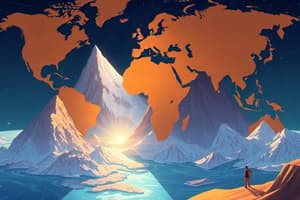Podcast
Questions and Answers
निम्नलिखित में से कौन सा कारक इंटरएक्शन को प्रभावित करता है?
निम्नलिखित में से कौन सा कारक इंटरएक्शन को प्रभावित करता है?
- जैव विविधता
- केवल सामाजिक तत्व
- संवेदनाएं
- दूरी और बाधाएँ (correct)
भौगोलिक सूचना प्रणाली (GIS) का मुख्य कार्य क्या है?
भौगोलिक सूचना प्रणाली (GIS) का मुख्य कार्य क्या है?
- सिर्फ मानचित्र बनाना
- भौगोलिक डेटा का संग्रहण, विश्लेषण और प्रदर्शन (correct)
- भौगोलिक डेटा का केवल प्रदर्शन
- सामाजिक डेटा संग्रहण
निम्न में से कौन सा एक भौगोलिक डेटा का उदाहरण है?
निम्न में से कौन सा एक भौगोलिक डेटा का उदाहरण है?
- जनसंख्या (correct)
- आर्थिक नीतियाँ
- राजनीतिक विचार
- संस्कृतिकेटा
भूस्थिति (Cartography) का क्या अर्थ है?
भूस्थिति (Cartography) का क्या अर्थ है?
भूगोल के अंतर्विषयक स्वरूप में क्या शामिल है?
भूगोल के अंतर्विषयक स्वरूप में क्या शामिल है?
भौगोलिकता के किस शाखा का अध्ययन जल संसाधनों और उनकी विशेषताओं पर केंद्रित है?
भौगोलिकता के किस शाखा का अध्ययन जल संसाधनों और उनकी विशेषताओं पर केंद्रित है?
कौन सा विकल्प मानव भूगोल की शाखा नहीं है?
कौन सा विकल्प मानव भूगोल की शाखा नहीं है?
निम्नलिखित में से कौन सा स्थान के अद्वितीय लक्षण का वर्णन करता है?
निम्नलिखित में से कौन सा स्थान के अद्वितीय लक्षण का वर्णन करता है?
भौगोलिक विश्लेषण में स्केल का क्या अर्थ है?
भौगोलिक विश्लेषण में स्केल का क्या अर्थ है?
कौन सा विकल्प भौतिक भूगोल की विशेषता है?
कौन सा विकल्प भौतिक भूगोल की विशेषता है?
कौन सा क्षेत्र 'दक्षिण' की भौगोलिक पहचान के लिए एक वर्णात्मक क्षेत्र है?
कौन सा क्षेत्र 'दक्षिण' की भौगोलिक पहचान के लिए एक वर्णात्मक क्षेत्र है?
भौगोलिकता में 'स्थानिक बातचीत' का क्या अर्थ है?
भौगोलिकता में 'स्थानिक बातचीत' का क्या अर्थ है?
भौगोलिकता के किस शाखा का अध्ययन मानव गतिविधियों और उनकी पर्यावरण पर प्रभाव पर केंद्रित है?
भौगोलिकता के किस शाखा का अध्ययन मानव गतिविधियों और उनकी पर्यावरण पर प्रभाव पर केंद्रित है?
Flashcards
Geography
Geography
The study of Earth's surface, its people, places, and how they interact.
Physical Geography
Physical Geography
Focuses on natural processes like climate, landforms and ecosystems.
Human Geography
Human Geography
Studies human activities, cultures, and their impact on the environment.
Location (Geography)
Location (Geography)
A place's position on Earth.
Signup and view all the flashcards
Absolute Location
Absolute Location
Precise coordinates (latitude and longitude).
Signup and view all the flashcards
Relative Location
Relative Location
Position of a place in relation to other places.
Signup and view all the flashcards
Region (Geography)
Region (Geography)
An area with shared characteristics.
Signup and view all the flashcards
Spatial Interaction
Spatial Interaction
The flow of people, goods, ideas, and information between locations.
Signup and view all the flashcards
Geographic Information Systems (GIS)
Geographic Information Systems (GIS)
A system for collecting, analyzing, and displaying geographic data, often used to create maps and overlay layers of information.
Signup and view all the flashcards
Spatial Distribution
Spatial Distribution
The arrangement of features across space, shown by patterns like clustered, dispersed, or linear.
Signup and view all the flashcards
Remote Sensing
Remote Sensing
Collecting data from a distance, using tools like satellites and aerial photography, to study the Earth.
Signup and view all the flashcards
Factors affecting Interaction
Factors affecting Interaction
Distance and barriers influence how people and things relate.
Signup and view all the flashcards
Geographic Data
Geographic Data
Location and details that describe an area (like population or elevation).
Signup and view all the flashcardsStudy Notes
Introduction to Geography
- Geography is the study of the Earth's surface, its people, places, and the interactions between them.
- It encompasses physical and human aspects of the planet.
- Physical geography focuses on natural processes like climate, landforms, and ecosystems.
- Human geography studies human activities, cultures, and their impact on the environment.
Branches of Geography
- Physical geography is concerned with natural phenomena.
- Branches within physical geography include:
- Geomorphology: studies landforms and their processes.
- Hydrology: studies water resources and their properties.
- Climatology: examines weather patterns and climate change.
- Biogeography: explores the distribution of living organisms and their environments.
- Soil geography: studies soil formation and distribution.
- Branches within physical geography include:
- Human geography examines human societies and their spatial aspects.
- Branches within human geography include:
- Population geography: studies the distribution and characteristics of human populations.
- Economic geography: examines economic activities and their spatial organization.
- Political geography: examines the spatial aspects of political processes and power.
- Cultural geography: studies the spatial aspects of culture and cultural landscapes.
- Urban geography: studies cities and urban development.
- Transportation geography: examines the spatial patterns of transportation systems.
- Historical geography: studies how the geography of a region has changed over time.
- Branches within human geography include:
Key Concepts in Geography
- Location: the position of a place on Earth.
- Absolute location: precise coordinates (latitude and longitude).
- Relative location: position of a place in relation to other places.
- Place: unique characteristics of a location.
- Human-made features (buildings, roads, etc.)
- Natural features (mountains, forests, etc.)
- Cultural characteristics (language, religion, traditions).
- Region: an area with shared characteristics.
- Formal regions: defined by shared characteristics (e.g., climate, language).
- Functional regions: defined by interactions (e.g., a city and its surrounding areas).
- Vernacular regions: perceived sense of place (e.g., the "South" in the U.S.).
- Scale: level of detail in geographic analysis.
- Global scale: entire Earth.
- Regional scale: a particular region.
- Local scale: a specific place or area.
- Spatial interaction: the flow of people, goods, ideas, and information between locations.
- Factors that affect interaction include distance and barriers.
- Spatial distribution: arrangement of features across space
- Patterns such as clustered, dispersed, linear.
Geographic Tools and Technologies
- Geographic Information Systems (GIS): used for collecting, analyzing, and displaying geographic data.
- Creating maps, overlaying layers of data.
- Remote sensing: collecting data from a distance (e.g., satellites, aerial photography).
- Global Positioning Systems (GPS): determining precise locations.
- Cartography: the art and science of mapmaking.
- Geographic data includes spatial location and associated attributes (e.g., population, elevation, land use.)
The Interdisciplinary nature of Geography
- Integrating elements from other disciplines like sociology, economics, environmental science, and political science.
- Solving complex problems that require an understanding of both human and physical systems.
- Recognising the interplay between human actions and environmental consequences.
Studying That Suits You
Use AI to generate personalized quizzes and flashcards to suit your learning preferences.




